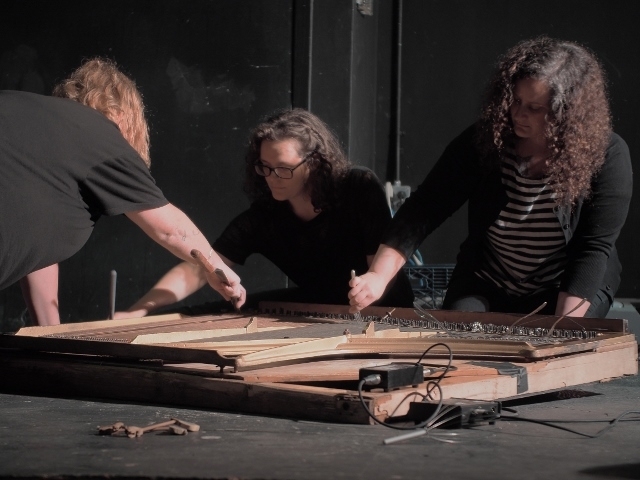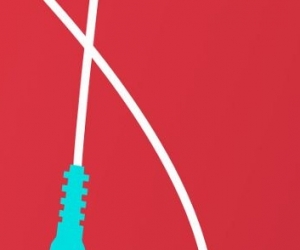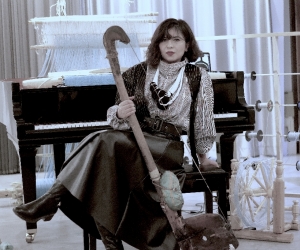
At the 2016 Winnipeg New Music Festival, the members of Burden and their synecdochical piano are set up in the midst of a noisy, beer-swilling crowd at Union Sound Hall. Without so much as a word of introduction to attract attention, they assume positions on three sides of the piano and begin. The only noise coming from the audience is the rustle of clothing and shuffling of boots as people quickly move closer to see what dark sonic atmosphere will be coaxed out of the piano. This kind of response and rapt attention have become commonplace at Burden concerts.
Doreen Girard, Caitlin Hutchison, and Shelagh Pizey-Allen formed Burden when they were all involved in Negative Space, a volunteer arts collective in downtown Winnipeg. Located in an unmarked building on Princess Street, Negative Space was committed to tenets of resistance politics and lasted for several years as a space for noncommercial artists and musicians (particularly women and gender nonconformists) to share their work.
Initially, Burden was playing pianos in a style close to what most people consider familiar. “We accumulated some pianos at Negative Space,” recalls Pizey-Allen. “I wanted to learn how to tune them . . . My aunt was getting rid of hers, and a couple more found their way to the space. We decided to figure out ways to amplify them and play as a group.”
Burden initially seemed intense for a band name, Hutchison says with a laugh, but it ended up being an inspired choice. “The word burden is a synonym for a refrain or chorus in a composition, but it can also refer to the lower, drony, bass sounds in a piece of music. In that sense, the word spoke to the sounds we were making, and the sounds we wanted to focus on getting from a piano.”
At first, the pursuit of such sounds played out with each musician at a separate piano—sometimes arranged with their backs to one another during a semi-improvised live performance. “Shelagh made [piezoelectric] contact microphones that we attached to the soundboard of each piano,” explains Hutchison. Amplifying those microphones and using loop pedals offered a dramatic sound, while the players emphasized high volume and repetition in pursuit of swelling overtones.
The logistical challenge of carting around three pianos meant the trio’s early shows were restricted to Negative Space, though the group had discussed figuring out how to play elsewhere. Girard recalls, “We got asked to play this festival out in the woods, so we started experimenting with taking apart one of the pianos and amplifying sounds made with different tools.” Unable to get a piano into the forest, the group decided to try working with a scaled-down version of the instrument. The results were even more in line with their vision for what the project could be, and became a major turning point. From then on, the members of Burden have played together on one piano soundboard with iron plate and strings attached and a single contact microphone taped on.
Intrigued by the sonic possibilities unleashed by pulling the guts out of a piano, Burden has now spent several years refining its toolbox and making some splendid discoveries along the way. The hammers of the actual piano, which would normally be triggered by the keyboard to strike specific points on the strings, have been repurposed as hand tools, doing everything from brushing the strings to drumming on the soundboard and plate. Kitchen objects are strategically placed, in the spirit of early prepared piano projects.
“We’ll try whatever sounds interesting,” affirms Hutchison. “Rubber mallets, chains, forks, drumsticks, chunks of metal. Taking out the soundboard allows us access to the full length of the strings, as well as the points where they attach.” Explaining that the access to extra playing space has broadened the imagined possibilities of what objects may be used on it, she continues, “It’s not that I spend all my time seeking them out, but now, when going about my day, if I see objects, I’m more likely to think about their resonant possibilities.”
For most Burden concerts, the trio sets up in the middle of a room and plays on the floor rather than a raised stage. The players align themselves around the edges of the piano, sitting down and facing one another. Music audiences are generally not accustomed to such a configuration, and its visual effect can provoke a sense of mystery before the group even starts to play its unconventional pieces. Another appreciable outcome of playing on the floor is a heightened physical sensation, as the audience can feel some of the tones working from their feet and upward through the body.
For live performances, Burden prefers to have the audience surround them and walk around. “The sound experience will be different in each location, and listening from a different angle might let you hear something you weren’t noticing before,” Girard says.
Whether audience members wander around or not, being in the room while Burden plays is a surprisingly physical experience. Each performance incorporates aggressive rubs, delicate prods, metallic taps, and whatever else shakes out of the group’s bag of tricks. The trio usually has some themes and cues sketched out, but there is always a good deal of improvisation as well. It all adds up to a sound environment that’s fraught with tension, rich in drones and overtones, and can shift, with little warning, from a warm, spacious percussive beat to a terrifying industrial cacophony.
The aforementioned performance at the Winnipeg New Music Festival featured the unveiling of a striking new tool, fishing line. Teased along the strings and joints of the piano, its bow-like effect yields a steady drone. That night the fishing line was used in a rhythmic manner, increasing the visual intrigue by occasioning an extremely focused dance driven by swooping arms.
Multiple players performing on a single piano is relatively commonplace, with some variant taking place at a piano bar or in a variety show where it is played up as a kind of parlour trick. But removing the expected means of control—the keyboard—has the effect of forcing these trained players to think deeply about the mechanics of the instrument.
“Having the whole soundboard to work with creates opportunities for more sounds,” explains Pizey-Allen. “But it also creates some difficulty, because now we’re all playing the same instrument. That’s a major adjustment.”
Furthermore, each player must rethink her approach to what had been a familiar instrument. “We all have some kind of classical-piano background,” Girard says. “At first, adjusting to playing without the keyboard was as much a challenge as playing it with two other people. Technique wasn’t a big concern because there aren’t really any rules for how to do this.” The trio needed to listen more actively when they began playing off the same soundboard.
While few artists work in this idiom, Pizey-Allen cites Andrea Neumann as a helpful reference point. “[Neumann] is this German artist who also works with an amplified piano, I guess she got so into playing this instrument that she had a special one built for herself [without cast iron] so it’s very light”—a major consideration in making this kind of work portable.
Although lacking a light, customized instrument, Burden has been able to present its work in several cities, playing shows with the likes of Merzbow, Stephen O’Malley, and Jean-Sébastien Truchy, among others, and shaking the skeletons of audiences at festivals such as Sounds Like (Saskatoon) and send+receive (Winnipeg). Their staggering performance at the latter is still cited by numerous local fans as the night they discovered the power of Burden’s music.
Photo: (left to right) Caitlin Hutchison, Shelagh Pizey-Allen, and Doreen Girard of Winnipeg trio Burden. Photo by: Robert Szkolnicki.


